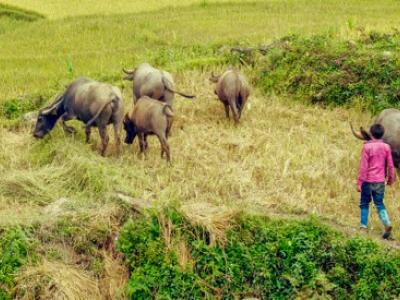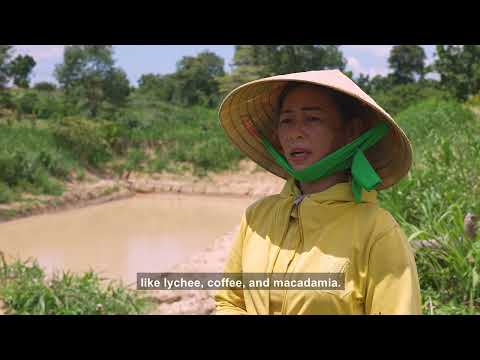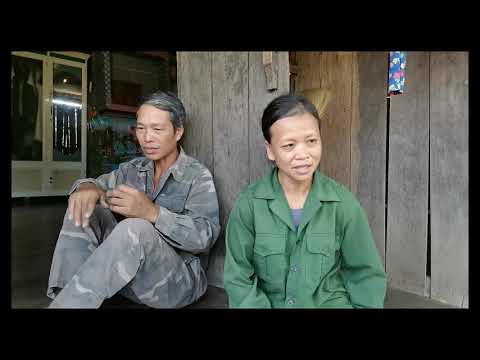
Photo:
Viet Nam is particularly vulnerable to climate change and already impacted by more irregular and intense climate variability. Every year the country is affected by a range of hydro-meteorological and climatological hazards, from droughts and forest fires to storms, floods and extreme temperatures.
Small-scale farmers with plots of less than one hectare, who are dependent on one or two rain-fed crops per year, are the most vulnerable to changes in water availability and its effect on agricultural productivity.
This project (2020 - 2026) will empower smallholder farmers in five provinces of the Central Highlands and South-Central Coast regions of Vietnam (Dak Lak, Dak, Nong, Binh Thuan, Ninh Thuan and Khanh Hoa) – particularly women and ethnic minority farmers - to manage increasing climate risks to agricultural production.
- Community
- Country Office
- Local Governments
- National Governments
- Non-Governmental Organizations
- Private Sector Partners
- United Nations Development Programme (UNDP)
222,412 direct beneficiaries and 335,252 indirect beneficiaries
- Viet Nam Ministry of Agriculture and Rural Development
- Green Climate Fund
Expected outcomes
Output 1: Strengthening the resilience of smallholder agriculture to climate change- induced water insecurity in the Central Highlands and South- Central Coast regions of Vietnam
Activity 1.1: Establish large- scale irrigation infrastructure to bring irrigation water to eight farming areas across the target regions
Activity 1.2: Establish last-mile connections between WEIDAP irrigation infrastructure and the poor and near poor farmer lands to help cope with increasing rainfall variability and drought
Activity 1.3: Enhance supplementary irrigation for rain fed smallholders to cope with rainfall variability and drought
Activity 1.4: Increase smallholder capacities to apply on-farm water efficient practices and technologies to maximize water productivity in coping with rainfall variability and drought
Output 2 Increased resilience of smallholder farmer livelihoods through climate- resilient agriculture and access to climate information, finance, and markets
Activity 2.1: Investments in inputs and capacities to scale up climate-resilient cropping systems and practices (soil, crop, land management) among smallholders through Farmer Field Schools
Activity 2.2: Technical assistance for enhancing access to markets and credit for sustained climate-resilient agricultural investments by smallholders and value chain actors
Activity 2.3: Co- development and use of localized agro-climate advisories by smallholders to enhance climate- resilient agricultural production
Viet Nam is particularly vulnerable to climate change and already impacted by more irregular and intense climate variability and change. Every year the country is affected by a range of hydro-meteorological and climatological hazards: droughts and forest fires during January-April; tropical, hail and wind storms; coastal, riverine, and flash floods; heavy rainfall and landslides in June-December and extreme temperatures (cold and heat waves) throughout the year.
Increased exposure of people and economic assets has been the major cause of long-term increases in economic losses from weather- and climate-related disasters.
Changes in precipitation are leading to hotter and wetter wet seasons and hotter and drier dry seasons, resulting in periods of increasing deficits in surface and ground water availability for agricultural production with longer periods of severe water scarcity during the dry season and increased frequency and intensity of droughts.
As a consequence, overall agricultural productivity is falling, with the corresponding declines in yields and incomes particularly harmful to small-scale farmers vulnerable to reduced water availability on rain fed lands and within this group, poor and near- poor, ethnic minority and women farmers.
Two of the regions most vulnerable to climate risks are the Central Highlands and South-Central Coast.
Agriculture and water resources are the foundation of the livelihoods of about 64% of the people in the Central Highlands, especially ethnic minorities accounting for 36.4 – 39.1% of the region’s population. The Central Highlands are susceptible to changes in water availability in the dry season when there is little rain and low river flow. Only about 27.8% of the region’s agricultural land is irrigated, and farmers are forced to exploit groundwater for irrigation.
The Central Highlands region constitutes Vietnam’s largest perennial crop zone, where smallholders produce coffee, pepper, cashew, rubber, tea, and a variety of fruit, primarily for market. In addition, they produce rice, maize and cassava, chiefly for local consumption, especially by the poorest.
Farmers in the region currently intercrop perennial crops or combinations of perennial and annual crops as a strategy to mitigate the risk of drought and market price fluctuation. However, under increasingly extreme climate change-induced drought, farmers’ coping strategies are progressively less effective. During droughts, groundwater levels can plunge throughout the region from 80-100 m in depth. Many farmers drill three or four wells but are still unable to obtain sufficient water, augmenting their dependence on increasingly variable rainfall.
Around 48% of the people in the South-Central Coast region of Vietnam rely on agriculture for their livelihoods, with ethnic minorities comprising from 5.7% of the population in Khanh Hoa province to 23.1% in Ninh Thuan. Sufficient, reliable water sources are particularly critical as the South-Central Coast is the driest area of the country with a long dry season, the lowest rainfall, and a relatively small river system. Only around 30% of agricultural land is irrigated, leaving many farmers reliant on rainfall. Under climate change, droughts in the region are becoming more extreme, and it’s anticipated that many of the poor/near-poor are likely to face food insecurity and increasing poverty.
The objective of this project, then, is to empower vulnerable smallholders in five provinces of the Central Highlands and South-Central Coast regions – particularly women and ethnic minority farmers - to manage increasing climate risks to agricultural production.
To achieve its objective, the project will enable smallholder farmers to adapt to climate-driven rainfall variability and drought through implementation of two linked Outputs integrating GCF and co-financing resources from the Asian Development Bank and the Government of Vietnam: 1) improved access to water for vulnerable smallholder farmers for climate-resilient agricultural production in the face of climate-induced rainfall variability and droughts, and 2) strengthened capacities of smallholder farmers to apply climate and market information, technologies, and practices for climate-resilient water and agricultural management.
While this project will use GCF financing to specifically target ethnic minority, women and other poor/near poor farmers, it will use GCF and co-financing resources to build the capacities of all farmers in climate vulnerable areas; as such the project will reach 222,412 direct individual beneficiaries in the five provinces of Dak Lak, Dak, Nong, Binh Thuan, Ninh Thuan and Khanh Hoa.
The project was developed as part of an integrated programme funded through multiple sources, as envisaged by the Government of Vietnam (GoV), that was aimed at enhancing water security and building the climate change resilience of the agriculture sector focusing on Vietnam’s Central Highland and South-Central Coastal Regions.
In alignment with this programme, the project will enable the GoV to adopt a paradigm shift in the way smallholder agricultural development is envisioned and supported through an integrated approach to agricultural resilience starting with planning for climate risks based on identification and analysis of agroecosystem vulnerabilities; enhancing water security and guaranteeing access; scaling up adoption and application of climate-resilient agricultural practices and cropping systems; and creating partnerships among value chain stakeholders to ensure access to market and credit.
This approach directly addresses climate risks while also establishing or strengthening institutional capacities for long-term multi-stakeholder support to vulnerable smallholders.
The project was designed to achieve smallholder adaptation to climate change in the most vulnerable districts and communes by complementing and enhancing the activities and results of the Water Efficiency Improvement in Drought Affected Provinces – WEIDAP – project for primary irrigation infrastructure financed through a USD 99.59 million loan from the Asian Development Bank, as well as USD 22.06 million from the Government of Vietnam.
GCF funding will be used a) to achieve last mile connections to this infrastructure by poor/near-poor smallholders, with a particular focus on ethnic minority and women farmers; and b) to attain adoption by all farmers in WEIDAP-served areas of climate-resilient agricultural practices, co-development and use of agro-climate information for climate risk management, and multi-stakeholder coordination for climate- resilient value chain development through climate innovation platforms.
This project will advance the implementation of priority activities in Viet Nam’s Nationally Determined Contribution (NDC). These include: support livelihoods and production processes that are appropriate under climate change conditions and are linked to poverty reduction and social justice; implement community-based adaptation, including using indigenous knowledge, prioritizing the most vulnerable communities; implement integrated water resources management and ensure water security; ensure food security through protecting, sustainably maintaining and managing agricultural land; and adopt technology for sustainable agriculture production and the sustainable use of water resources.
Output 1: Strengthening the resilience of smallholder agriculture to climate change- induced water insecurity in the Central Highlands and South- Central Coast regions of Vietnam
Activity 1.1: Establish large- scale irrigation infrastructure to bring irrigation water to eight farming areas across the target regions
1.1.1 185 km of new pipe systems taking water from canals or reservoirs, and supplying hydrants located at a reasonable distance from a farmer’s field
1.1.2 19,200 ha served through modernization of main system including canal lining, control structure, balancing storage and installation of flow control and measurement devices with remote monitoring
1.1.3 Provision of new and improved weirs replacing farmer constructed temporary weirs, permanent ponds/storage for irrigating HVCs, and upgrades of upstream storage and supply systems.
Activity 1.2: Establish last-mile connections between WEIDAP irrigation infrastructure and the poor and near poor farmer lands to help cope with increasing rainfall variability and drought
1.2.1 Design and construct 4,765 connection and distribution systems including installation and maintenance of irrigation equipment to cope with climate variability on 1,430 hectares
1.2.2 Train 4,765 poor and near poor farmers (one connection/distribution system per farmer) on climate-risk informed utilization of irrigation equipment and system maintenance
1.2.3 Establish Water Users Groups for O&M of communal or shared systems, including structures and agreements on potential funding mechanisms
Activity 1.3: Enhance supplementary irrigation for rain fed smallholders to cope with rainfall variability and drought
1.3.1 Construct or upgrade 1,159 climate-resilient ponds (based on site-specific designs construct 675 new ponds and upgrade 484 existing ponds)
1.3.2 Train over 16,000 poor and near-poor farmer beneficiaries in climate- resilient water resource management to enhance supply
1.3.3 Establish 185 pond- management groups for O&M, including structures and agreements on potential funding mechanisms
Activity 1.4: Increase smallholder capacities to apply on-farm water efficient practices and technologies to maximize water productivity in coping with rainfall variability and drought
1.4.1 Train 30 DARD staff and champion farmers in 14 districts (one course in years 2, 4 and 6) to support farmers’ groups in co-design, costing and O&M of climate-resilient, water efficient technologies
1.4.2 Train over 21,200 farmers through 900 Farmer Field Schools on soil and biomass management to enhance moisture-holding capacity, recharge of groundwater, and water productivity to cope with evolving climate risks on water security (in conjunction with Activity 2.1)
1.4.3 Install on-farm water efficiency systems for 8,621 poor/near-poor smallholders linked to performance-based vouchers (linked to Activity 2.1)
1.4.4 Train smallholder farmers in five provinces on climate-risk informed O&M of water efficiency technologies
Output 2 Increased resilience of smallholder farmer livelihoods through climate- resilient agriculture and access to climate information, finance, and markets
Activity 2.1: Investments in inputs and capacities to scale up climate-resilient cropping systems and practices (soil, crop, land management) among smallholders through Farmer Field Schools
2.1.1 Sensitize smallholders to establish/re-activate 900 Farmer Field Schools
2.1.2 Train DARD personnel and lead (champion) farmers, as well as other interested parties (NGOs, Farmers and Women’s Unions, etc.) to build a cadre of farmer champions to galvanize adoption and application of CRA packages (15 provincial level workshops for 30 DARD staff in years 2,4 and 6; 28 district and 120 commune level trainings for 30 lead farmers in years 2 and 6)
2.1.3 Train over 21,200 farmers and value chain actors – particularly private sector input providers, buyers, processors, transporters - through 900 FFS on scaling up of climate resilient cropping systems and practices. (Each FFS will conduct 1-day trainings twice per year)
2.1.4 investment support to 8,621 targeted poor/near poor smallholders to acquire inputs and technologies for implementation of the CRA packages through performance-based vouchers.
2.1.5 Participatory auditing of implementation of voucher systems for climate resilient cropping systems and practices (One 1-day meeting for 100 participants in each of the 60 communes in Years 2, 4 and 6)
Activity 2.2: Technical assistance for enhancing access to markets and credit for sustained climate-resilient agricultural investments by smallholders and value chain actors
2.2.1 Establish and operationalize multi- stakeholder Climate Innovation Platforms (CIP) in each province and at the level of agro-ecological zones (Annual stakeholder meetings organized once every two years in each of the 5 provinces)
2.2.2 Provide technical assistance and training to enable market linkages with input, information and technology providers and buyers for climate-resilient agricultural production (two trainings, two networking workshops and three trade fairs in each of the 14 districts over four years)
2.2.3 Provide technical assistance and train farmers to enable access to credit through financial intermediaries (One workshop in each of the 60 communes in years 2 and 4)
Activity 2.3: Co- development and use of localized agro-climate advisories by smallholders to enhance climate- resilient agricultural production
2.3.1 Train 50 hydromet and DARD staff on generating and interpreting down-scaled forecasts for use in agricultural planning (eight training over four years for 50 participants)
2.3.2 Provide technical assistance for the formation ACIS technical groups and training of 420 participants at district level (1-day workshops for 30 participants in each of the 14 districts)
2.3.3 Co-develop, through Participatory, Scenario Planning (PSP) of seasonal and 10-day/15-day agro-climate advisories with smallholder farmers (20 provincial level trainings for 30 staff and 56 district level trainings for 60 participants over four years)
2.3.4 Disseminate advisories to 139,416 households in the 60 communes
Project-level monitoring and evaluation will be undertaken in compliance with the UNDP POPP and UNDP Evaluation Policy.
The primary responsibility for day-to-day project monitoring and implementation rests with the Project Manager.
The UNDP Country Office supports the Project Manager as needed. Additional M&E, implementation quality assurance, and troubleshooting support will be provided by the UNDP Regional Technical Advisor. The project target groups and stakeholders including the NDA Focal Point will be involved as much as possible in project-level M&E.
A project implementation report will be prepared for each year of project implementation. The final project PIR, along with the terminal evaluation report and corresponding management response, will serve as the final project report package.
Semi-annual reporting will be undertaken in accordance with UNDP guidelines for quarterly reports that are produced by the project manager.
An independent mid-term review, equivalent to an Interim Review in GCF terminology, will be undertaken and the findings and responses outlined in the management response will be incorporated as recommendations for enhanced implementation during the final half of the project’s duration.
An independent terminal evaluation will take place no later than three months prior to operational closure of the project and will be made available on the UNDP Evaluation Resource Centre.
The UNDP Country Office will retain all M&E records for this project for up to seven years after project financial closure.
- UNDPYusuke TaishiRegional Technical Advisor, Climate Change Adaptation
- UNDP Viet NamDao Xuan LaiAssistant Resident Representative, Head of Environment and Climate Change Department












